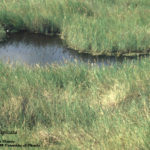Distichlis spicata
What is Salt Grass?
Physical Characteristics
Leaves:
- Grass
- Opposite
- Stiff
- Flat, folded or rolled
- Sharp point at tip
- 1-6 inches long
- 0.25 inches wide
Flowers:
- Wide
- Spikey
- Up to 3 inches long
- Spikelets tan
Seeds:
- Small nut
- Smooth
- Oval-shaped
- 0.06 inches long
Stem:
- Grow from rhizomes
- Up to 2 feet tall
- Rigid texture
Where Does it Grow?
Salt grass can be found in brackish coastal marshes.
Pros and Cons of Salt Grass
Salt grass is an important food source for birds and geese. Submerged portions of all aquatic plants provide habitats for many micro and macro invertebrates. These invertebrates in turn are used as food by fish and other wildlife species (e.g. amphibians, reptiles, ducks, etc.). After aquatic plants die, their decomposition by bacteria and fungi provides food (called “detritus”) for many aquatic invertebrates.



